Historical Analysis of Stock Market Behavior Following Fed Interest Rate Cuts
Stock-Markets / US Stock Markets Sep 19, 2007 - 11:30 AM GMTBy: Chris_Ciovacco

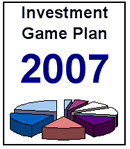 Developments in financial markets since the Committee's last regular meeting have increased the uncertainty surrounding the economic outlook. The Committee will continue to assess the effects of these and other developments on economic prospects and will act as needed to foster price stability and sustainable economic growth.." - Federal Open Market Committee, 09/18/2007
Developments in financial markets since the Committee's last regular meeting have increased the uncertainty surrounding the economic outlook. The Committee will continue to assess the effects of these and other developments on economic prospects and will act as needed to foster price stability and sustainable economic growth.." - Federal Open Market Committee, 09/18/2007
With the Federal Reserve (Fed) lowering its target discount rate (interest rate) by 0.50% on September 18, 2007, it is prudent to examine how stocks behaved in the year following similar historical rate cuts. I chose to focus on the Fed rate cuts in 1986, 1995, 1998, and 2001 since the current Target Federal Funds Rate (Fed Funds Rate) of 5.25% (prior to the cut) and the current published inflation rate of 2.50% are similar to the rates found in those years.
Another factor in choosing to examine the years above is the market's expectation of how low the Fed could possibly go during a lowering cycle is heavily dependent on where rates start from. For example, prior to the first rate cut in June of 1981, the Federal Funds Rate was 20.00% and published inflation rate was 8.94% (full-year 1981). June of 1981 is vastly different from September of 2007. As a result, I see limited value in examining how stocks behaved after the 1981 cut or other periods which were significantly different from today. Below is the approximate Fed Funds Rate and published annual inflation figures for each respective period.
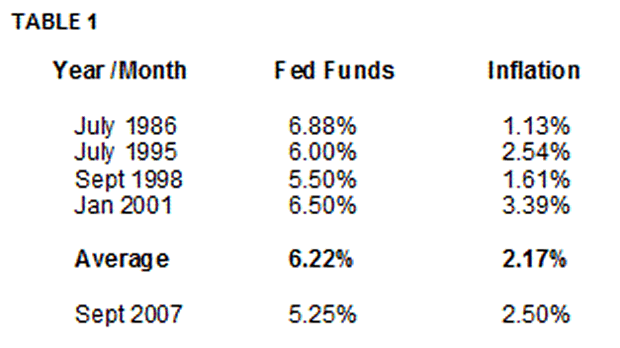
Since the current Fed Funds Rate of 5.25% (prior to the cut) is lower than the average of 6.22% in the previous study periods and inflation is slightly higher (see TABLE 1 above), the Fed probably has less room to move rates lower in 2007. The average number of rate cuts in cycles which began in 1986, 1995, 1998, & 2001 was 5.5 and the total magnitude of those cuts averaged 1.97%. Since PE ratios were off the charts in 2001, I also feel 1986, 1995, and 1998 offer better comparisons to the current environment. If you remove 2001, the average number of cuts in the cycles which began in 1986, 1995, 1998 was 3.0 and the average total magnitude of those cuts was 0.79%.
Unless housing drags down the economy more than is expected (which could happen), I think it will be difficult for the Fed to lower rates by more than 2.00% over this cycle given current oil prices and general inflation climate. However, the 0.50% cut on September 18, 2007 says the Fed may have put inflation concerns on the back burner and on low heat. To get a better idea of how Fed rate cuts could impact stocks, we'll examine the historical results with and without 2001. Some figures for all nine rate cutting cycles since 1970 are also presented.
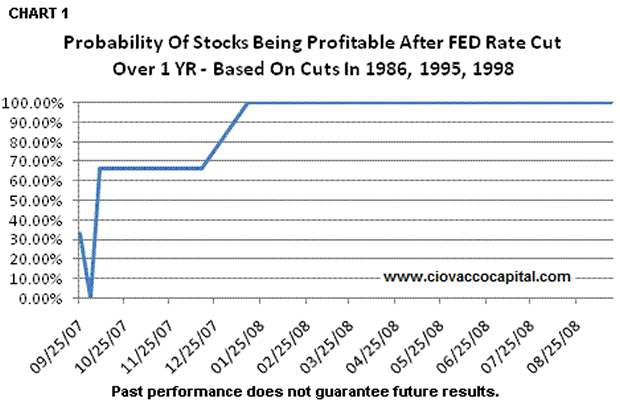
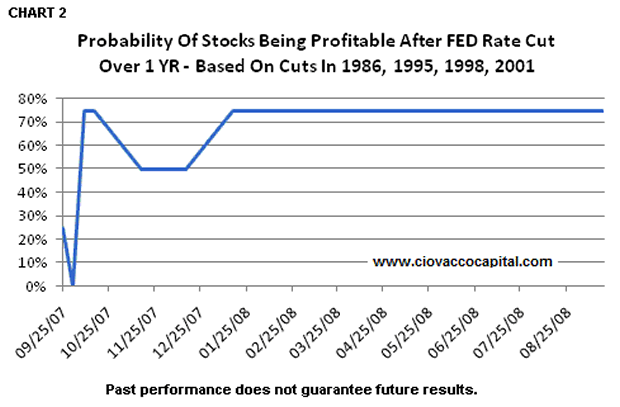
CHART 1 and CHART 2 above summarize the main point of the analysis, which is what are the odds (based on the historical periods studied) that stocks will be higher a year from now? The results are encouraging, but they also show it may be rough for a few weeks or months before stocks can hold on to some meaningful gains. In all cases (with and without 2001), stocks were lower two weeks after the first rate cut. As shown in CHART 1 and CHART 2, the probability of success improves significantly in the third week after the first rate cut. This means, based on history, we should be in no big hurry to move more money into stocks. It may be a good time to consider adding to our stock exposure during the third week after the cuts (after the initial euphoria wears off and if conditions warrant).
CHART 3, below, shows the average daily percent change of stocks after the first rate cut for both sets of data (with and without 2001). It gives us similar information to CHARTS 1 and 2, but with much more detail in terms of the timing of positive and negative outcomes for stocks during the first year after the first rate cut.
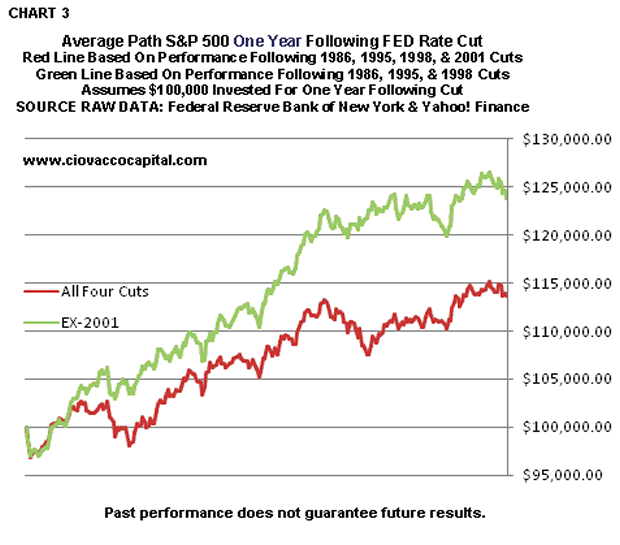
Using the stock market's reaction to rate cuts in 1986, 1995, and 1998, it took an average of 66 calendar days for the market to move permanently higher than the closing level on the day of the first rate cut. The average is somewhat deceptive since the number of calendar days was 170 in 1986, 13 in 1995, and 16 in 1998. If we don't end up looking like 2001(CHART 7) , there is a 66% chance the market will move permanently higher, within approximately 14 or 15 calendar days, relative to the closing price on the day of the first rate cut (1,519 on the S&P 500 in the Sept 2007 case). Moving above the level found on the day of the cut does not ensure longer-term success since the market began to head toward new bear market lows roughly one month after the first rate cut on January 3, 2001.
Therefore, based on these four cases, it would be a positive sign if the market made a new high, relative to the closing level on the day of the first cut, sometime 30 calendar days after the rate cut. Said another way, it would be a positive for stocks if a new high, relative to the close on September 18, 2007 (1,519 on the S&P 500), was made after October 19, 2007. This new high would increase the odds we are not in a period which looks like the negative outcome following the first rate cut in 2001.
The S&P 500 was 27.31% higher one year after the first Fed rate cut in July of 1986 (CHART 4 below).
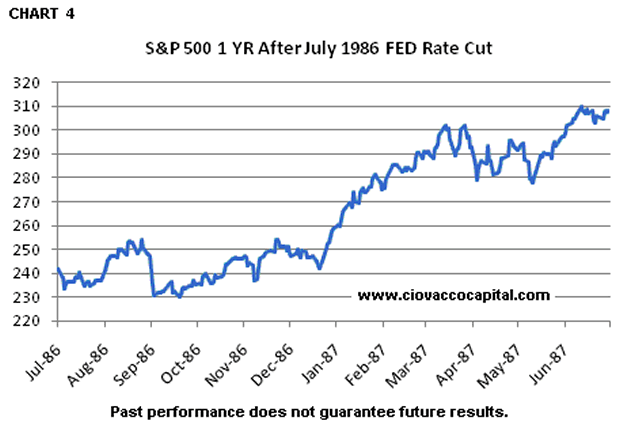
The S&P 500 was 18.67% higher one year after the first Fed rate cut in July of 1995 (CHART 5 below).

The S&P 500 was 20.91% higher one year after the first Fed rate cut in Sept 1998 (CHART 6 below).
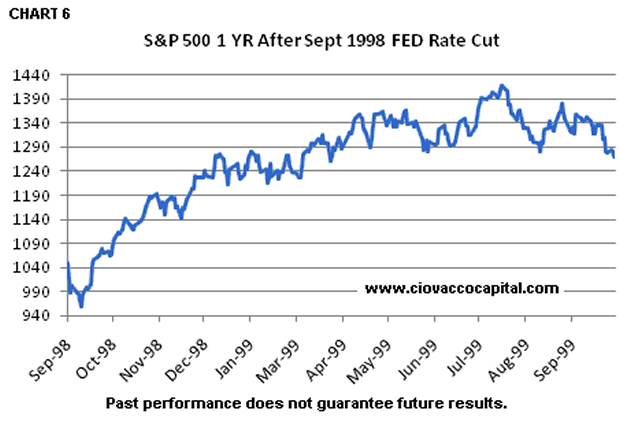
The S&P 500 was 13.52% lower one year after the first Fed rate cut in Jan 2001 (CHART 7 below).
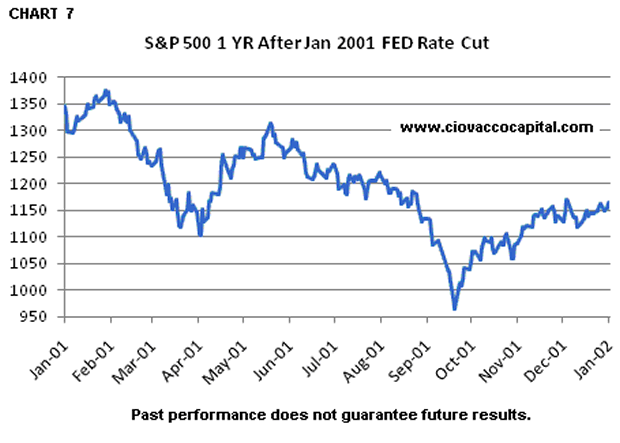
After some initial positive reactions by investors, a negative reaction in the coming days to the rate cut would not be a big surprise. For example, using the four cases, the average loss on the day after the cut (September 19, 2007 in our case) was -1.46%. Only in 1995 was the market able to post positive results (0.43%) on the first full trading day after the Fed cut.
What does it mean for our investments? We know the odds favor a positive outcome for stocks over the next 12 months, possibly after a period of weakness. CHART 7 above also illustrates a rate cut alone does not guarantee success after 12 months . The S&P 500 was 13.52% lower one year after the first Fed rate cut made in January of 2001. The average gain for the S&P 500 one year after the first rate cut for all four periods was 13.34%. The average gain for the S&P 500 one year after the first rate cut if you remove 2001 was 22.30%. While a Fed rate cut is one of many factors that will influence stocks over the next 12 months, it is one of the most important in the eyes of Wall Street. In very simple terms, based on these four historical cases, which are similar to today's environment, there is a 75% chance stocks will be higher a year from September 18, 2007. This does not call for blind optimism, but it does call for controlled optimism.
1970-2007: Some Other Rate Cut Facts
Since 1970, the S&P 500 has risen by an average of 5.5% in the three months after the Fed's first rate cut. Only twice in the nine instances (22% of the time) since 1970 did stocks lose ground, including an 18% fall after the first cut in 2001. The average gain after the nine cuts since 1970 over the next six months was 12.3% (Source: Barron's). If we use these nine rate reduction cycles, the odds of a successful outcome over the next three months is roughly 88%.
Since monetary inflation via credit expansion is a key element in our investment strategy, this recent move by the Fed should be beneficial to our portfolios. All risk assets, as well as gold and silver, should benefit from lower borrowing costs and continued expansion of the money supply.
Chris Ciovacco
Ciovacco Capital Management
Copyright (C) 2007 Ciovacco Capital Management, LLC All Rights Reserved.
Chris Ciovacco is the Chief Investment Officer for Ciovacco Capital Management, LLC. More on the web at www.ciovaccocapital.com
Ciovacco Capital Management, LLC is an independent money management firm based in Atlanta, Georgia. As a registered investment advisor, CCM helps individual investors, large & small; achieve improved investment results via independent research and globally diversified investment portfolios. Since we are a fee-based firm, our only objective is to help you protect and grow your assets. Our long-term, theme-oriented, buy-and-hold approach allows for portfolio rebalancing from time to time to adjust to new opportunities or changing market conditions. When looking at money managers in Atlanta, take a hard look at CCM.
All material presented herein is believed to be reliable but we cannot attest to its accuracy. Investment recommendations may change and readers are urged to check with their investment counselors and tax advisors before making any investment decisions. Opinions expressed in these reports may change without prior notice. This memorandum is based on information available to the public. No representation is made that it is accurate or complete. This memorandum is not an offer to buy or sell or a solicitation of an offer to buy or sell the securities mentioned. The investments discussed or recommended in this report may be unsuitable for investors depending on their specific investment objectives and financial position. Past performance is not necessarily a guide to future performance. The price or value of the investments to which this report relates, either directly or indirectly, may fall or rise against the interest of investors. All prices and yields contained in this report are subject to change without notice. This information is based on hypothetical assumptions and is intended for illustrative purposes only. THERE ARE NO WARRANTIES, EXPRESSED OR IMPLIED, AS TO ACCURACY, COMPLETENESS, OR RESULTS OBTAINED FROM ANY INFORMATION CONTAINED IN THIS ARTICLE. PAST PERFORMANCE DOES NOT GUARANTEE FUTURE RESULTS.
© 2005-2022 http://www.MarketOracle.co.uk - The Market Oracle is a FREE Daily Financial Markets Analysis & Forecasting online publication.



